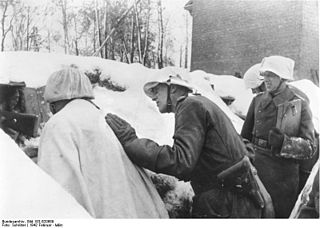
The 6th Army was a field army unit of the German Wehrmacht during World War II (1939–1945). It was widely remembered for being the most highly decorated German army unit until its defeat by the Red Army at the Battle of Stalingrad in the winter of 1942–1943. It also acquired a reputation for the war crimes that it committed under the command of Field Marshal Walther von Reichenau during Operation Barbarossa.

The Prague offensive was the last major military operation of World War II in Europe. The offensive was fought on the Eastern Front from 6 May to 11 May 1945. Fought concurrently with the Prague uprising, the offensive significantly helped the liberation of Czechoslovakia in 1945. The offensive was one of the last engagements of World War II in Europe and continued after Nazi Germany's unconditional capitulation on 8/9 May.

The 18th Army was a World War II field army in the German Wehrmacht.
The XXVIII Army Corps was a corps which served in Nazi Germany's Wehrmacht during World War II. The corps was created on May 20, 1940 in Wehrkreis III. During the war, the corps was subordinated to the German 6th, 16th, 18th, and 3rd Panzer Armies. In 1945, the corps was briefly named Armeeabteilung Samland. The corps fought in Samland until annihilated in late April 1945.

The XV SS Cossack Cavalry Corps was a World War II cavalry corps of the Waffen-SS, the armed wing of the German Nazi Party, primarily recruited from Cossacks.
Army Detachment Steiner, also referred to as Army Group Steiner or Group Steiner, was a temporary military unit (Armeegruppe-type), mid-way in strength between a corps and an army, created on paper by Adolf Hitler on 21 April 1945 during the Battle of Berlin, and placed under the command of SS-Obergruppenführer Felix Steiner.
The 21st Infantry Division was a German military unit which fought during World War II.

The 19th Waffen Grenadier Division of the SS was an infantry division of the Waffen-SS during World War II. It was the second Latvian division formed in January 1944, after its sister unit, the 15th Waffen Grenadier Division of the SS with which it formed the Latvian Legion. It was surrounded in the Courland Pocket at the end of the war where it surrendered to the Red Army.
The XXIX Army Corps was an infantry corps of the German Army during World War II, active from 1940 to 1945.
The CI Army Corps, alternatively also referred to as Roman 101st Corps, was a corps-level unit of the German Wehrmacht during World War II. It existed only for a few months during the year 1945.

The XXVI Army Corps was a Wehrmacht army corps during World War II. It existed from 1939 to 1945. It was also known as Corps Wodrig during the Invasion of Poland.
The LXIII Army Corps was an army corps of the German Wehrmacht during World War II. The corps was formed in November 1944.
The LXVI Army Corps, initially known as the LXVI Reserve Corps, was an army corps of the German Wehrmacht during World War II. The corps was formed in September 1942.
The LXVII Army Corps, initially known as the LXVII Reserve Corps, was an army corps of the German Wehrmacht during World War II. The corps was formed in September 1942.
The LXXIV Army Corps was an army corps of the German Wehrmacht during World War II.
The LXXXI Army Corps was an army corps of the German Wehrmacht during World War II. The corps was established in occupied France in 1942 and remained active until 1945.
The LXXXII Army Corps was an army corps of the German Wehrmacht during World War II. It was formed in 1942 and existed until 1945.
The LXXXIII Army Corps was an army corps of the German Wehrmacht during World War II. It was formed in 1942 and existed until 1943. After its dissolution, the personnel of the LXXXIII Army Corps was used to form the staff of the new 19th Army.
The LXXXVI Army Corps was an army corps of the German Wehrmacht during World War II. It was formed in 1942 and existed until 1945.
The LXXXVIII Army Corps was an army corps of the German Wehrmacht during World War II. It was formed in 1942 and existed until 1945.







